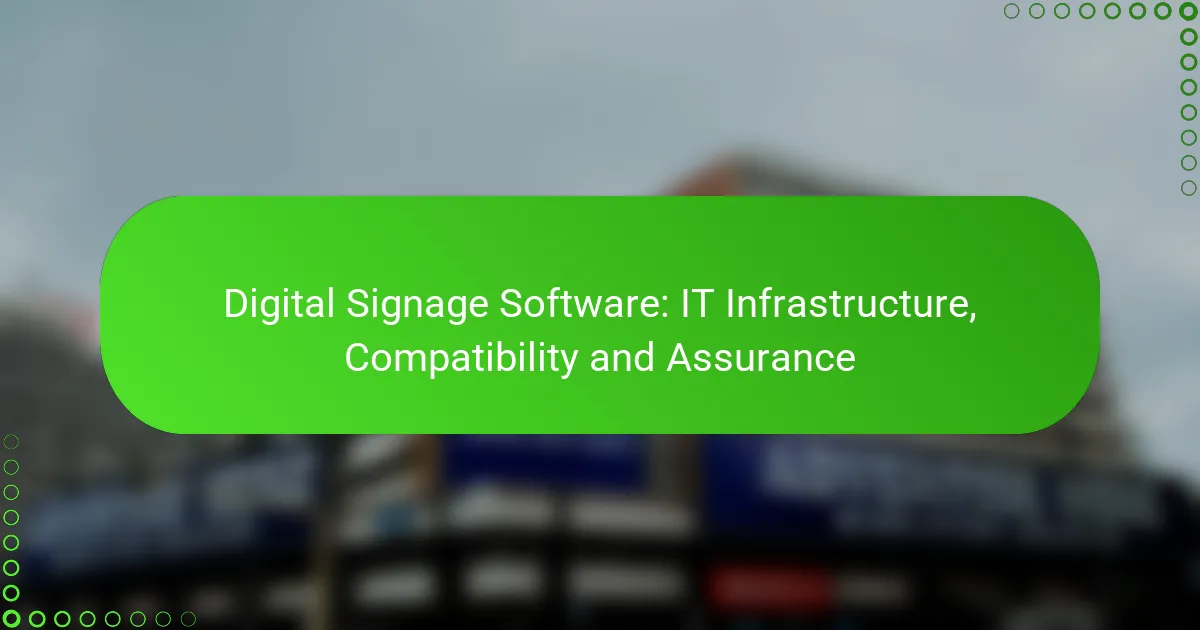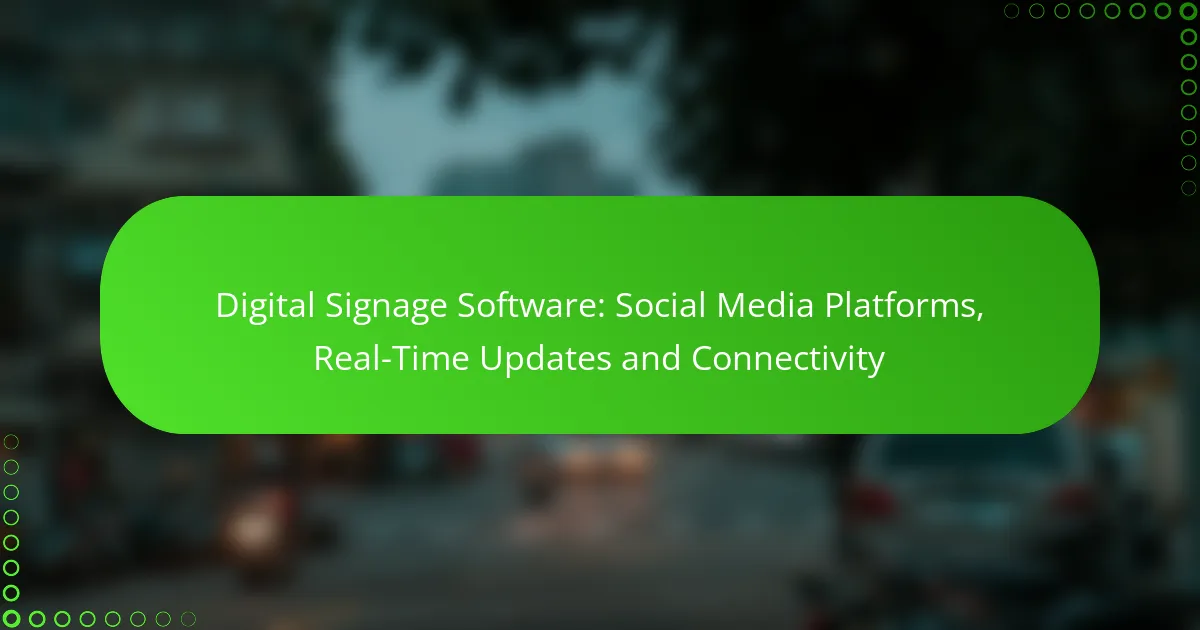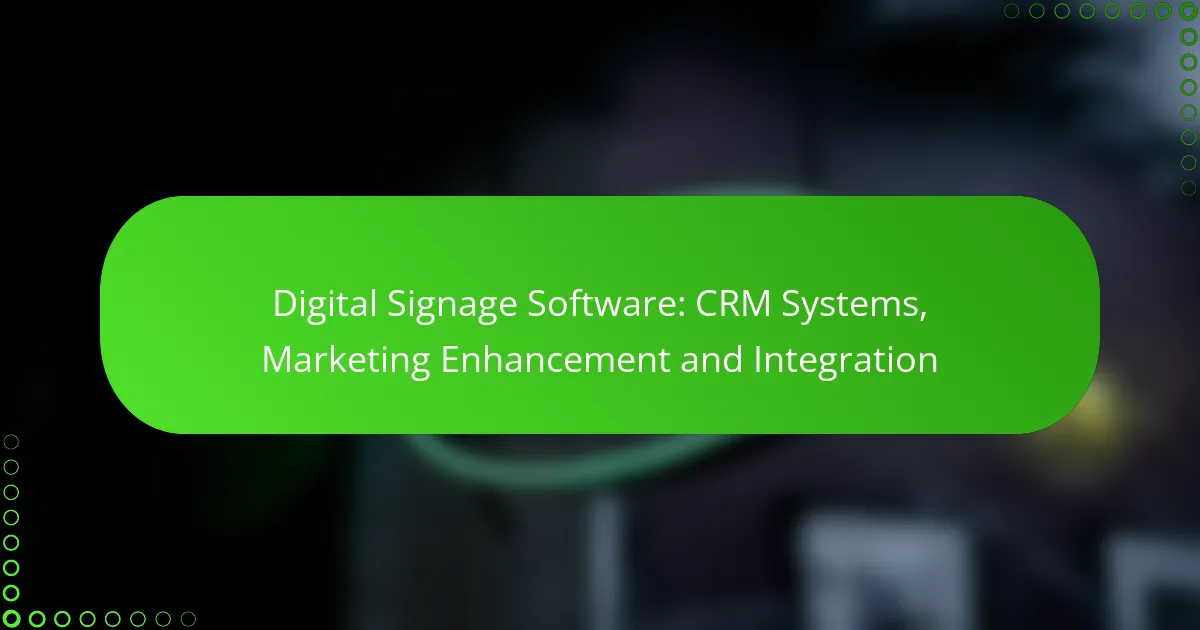Digital signage software plays a vital role in enhancing communication and engagement for businesses, with popular solutions like Scala, BrightSign, and ScreenCloud catering to diverse needs. The effectiveness of these platforms heavily relies on a solid IT infrastructure, including network capabilities and hardware compatibility, to ensure smooth content delivery. Additionally, meeting compatibility requirements across various devices and operating systems is essential for optimal performance and integration with existing content management systems.

What are the best digital signage software solutions in India?
Some of the top digital signage software solutions in India include Scala, BrightSign, ScreenCloud, Yodeck, and Signagelive. These platforms offer various features tailored to different business needs, such as content management, scheduling, and hardware compatibility.
Scala
Scala is a robust digital signage software known for its flexibility and scalability. It allows users to create, manage, and distribute content across multiple screens, making it suitable for large enterprises and retail environments.
Key features include a user-friendly interface, advanced analytics, and integration capabilities with third-party applications. Businesses can leverage Scala’s cloud-based solutions for easier content updates and management.
BrightSign
BrightSign is a popular choice for hardware-based digital signage solutions, offering a range of media players that work seamlessly with its software. It provides reliable performance and supports various content formats, including video, images, and HTML5.
BrightSign’s software includes features like remote management, interactive content capabilities, and real-time monitoring. This makes it ideal for businesses looking for a comprehensive solution that combines hardware and software.
ScreenCloud
ScreenCloud is a cloud-based digital signage platform that simplifies content management and distribution. It is particularly user-friendly, allowing non-technical users to create and update content easily.
With support for a wide range of devices and integration with apps like Google Slides and social media, ScreenCloud is suitable for businesses of all sizes. Its pricing model is flexible, catering to both small businesses and larger enterprises.
Yodeck
Yodeck is a cloud-based digital signage solution that stands out for its affordability and ease of use. It allows users to schedule and manage content from anywhere, making it ideal for businesses with multiple locations.
Yodeck supports various media types and offers features like remote management and real-time updates. Its competitive pricing makes it an attractive option for small to medium-sized businesses looking to implement digital signage.
Signagelive
Signagelive is a versatile digital signage platform that provides a range of features for content management and distribution. It supports various media formats and offers integration with numerous third-party applications.
With its cloud-based infrastructure, Signagelive allows for easy updates and remote management. It is suitable for businesses looking for a reliable solution that can scale as their needs grow.

How does IT infrastructure impact digital signage software?
The IT infrastructure significantly influences the performance and effectiveness of digital signage software. A robust network, compatible hardware, and the choice between cloud and on-premise solutions are crucial for seamless operation and content delivery.
Network requirements
Digital signage software relies heavily on network connectivity for content updates and real-time data integration. A stable and high-speed internet connection is essential, with bandwidth requirements varying based on the number of displays and content types, typically ranging from a few Mbps to several hundred Mbps.
Consider implementing a dedicated network for digital signage to avoid congestion from other devices. Regularly monitor network performance to ensure it meets the demands of your signage system, especially during peak usage times.
Hardware compatibility
Ensuring hardware compatibility is vital for the successful deployment of digital signage solutions. This includes checking that displays, media players, and any additional peripherals meet the software’s specifications and can support the required resolutions and formats.
When selecting hardware, prioritize devices that are designed for commercial use, as they often offer better durability and performance. Additionally, verify that the operating system and software versions are compatible to prevent operational issues.
Cloud vs on-premise solutions
The choice between cloud and on-premise digital signage solutions can greatly affect your IT infrastructure. Cloud solutions offer flexibility and scalability, allowing for easy updates and remote management, while on-premise solutions provide greater control and security but may require more upfront investment in hardware and maintenance.
Evaluate your organization’s needs, including budget, technical expertise, and security requirements, to determine the best fit. For example, businesses with limited IT resources may benefit from cloud solutions, while those with strict data regulations might prefer on-premise systems.

What are the compatibility requirements for digital signage software?
Digital signage software must meet specific compatibility requirements to function effectively across various platforms and devices. Key factors include operating system support, device compatibility, and integration with content management systems.
Operating system support
Digital signage software should be compatible with major operating systems such as Windows, macOS, and Linux. Each OS may have different performance characteristics and features, so it’s essential to choose software that aligns with your existing infrastructure.
When selecting software, verify that it supports the latest versions of the operating systems you plan to use. This ensures security updates and optimal performance, reducing the risk of compatibility issues.
Device compatibility
Compatibility with various devices is crucial for seamless digital signage deployment. The software should work with different display types, including LCD, LED, and projection systems, as well as media players and tablets.
Consider the hardware specifications of your devices, such as CPU and RAM requirements, to ensure smooth operation. It’s advisable to check manufacturer guidelines for supported devices to avoid potential pitfalls during installation.
Content management system integration
Effective digital signage software should integrate well with popular content management systems (CMS) to streamline content updates and scheduling. Look for software that supports APIs or plugins for easy integration with platforms like WordPress, Drupal, or custom CMS solutions.
Assess the ease of use and flexibility of the integration process. A well-integrated system can save time and reduce errors, enabling more efficient content management across multiple displays.

How to ensure digital signage software reliability?
To ensure the reliability of digital signage software, focus on regular updates, accessible technical support, and effective performance monitoring tools. These elements help maintain system functionality and address issues promptly, which is crucial for uninterrupted service.
Regular updates
Regular updates are essential for maintaining the reliability of digital signage software. These updates often include security patches, new features, and performance enhancements that can significantly improve system stability. Schedule updates during off-peak hours to minimize disruption.
Consider implementing an automatic update system if available, as this can help ensure that your software is always running the latest version without manual intervention. However, always back up your data before applying major updates to avoid potential issues.
Technical support availability
Having accessible technical support is critical for addressing any issues that may arise with digital signage software. Choose a provider that offers 24/7 support, as this ensures you can get help whenever you need it, especially during high-traffic periods.
Evaluate the support channels available, such as phone, chat, or email, and consider the average response times. A provider with a strong reputation for customer service can significantly reduce downtime and enhance overall reliability.
Performance monitoring tools
Performance monitoring tools are vital for tracking the health and efficiency of your digital signage software. These tools can provide real-time data on system performance, allowing you to identify and address issues before they escalate into major problems.
Look for software that offers analytics features, such as content engagement metrics and hardware performance statistics. Regularly review these metrics to optimize your content and ensure that your digital signage operates smoothly, which can lead to better audience engagement and satisfaction.

What are the key features to look for in digital signage software?
When selecting digital signage software, prioritize features that enhance usability, compatibility, and content management. Key functionalities include user-friendly interfaces, robust scheduling options, and support for various media formats.
Ease of Use
Ease of use is crucial for digital signage software, as it allows users to create and manage content without extensive training. Look for intuitive interfaces with drag-and-drop capabilities, which simplify the design process. A well-organized dashboard can help users quickly access tools and features.
Content Management
Effective content management is essential for maintaining dynamic displays. Choose software that offers centralized control over multiple screens, allowing for easy updates and scheduling. Features like templates and content libraries can streamline the creation process and ensure brand consistency.
Compatibility
Compatibility with various hardware and operating systems is vital for seamless integration. Ensure the software supports a range of display types, including LED, LCD, and projection systems. Additionally, check for compatibility with different content formats, such as images, videos, and live feeds.
Support and Updates
Reliable support and regular updates are important for keeping your digital signage software running smoothly. Look for vendors that offer comprehensive customer support, including tutorials, troubleshooting, and responsive service. Regular updates can enhance security and introduce new features, keeping your system up-to-date.
Analytics and Reporting
Analytics and reporting features help measure the effectiveness of your digital signage campaigns. Opt for software that provides insights into viewer engagement and content performance. This data can guide future content strategies and optimize display effectiveness.









